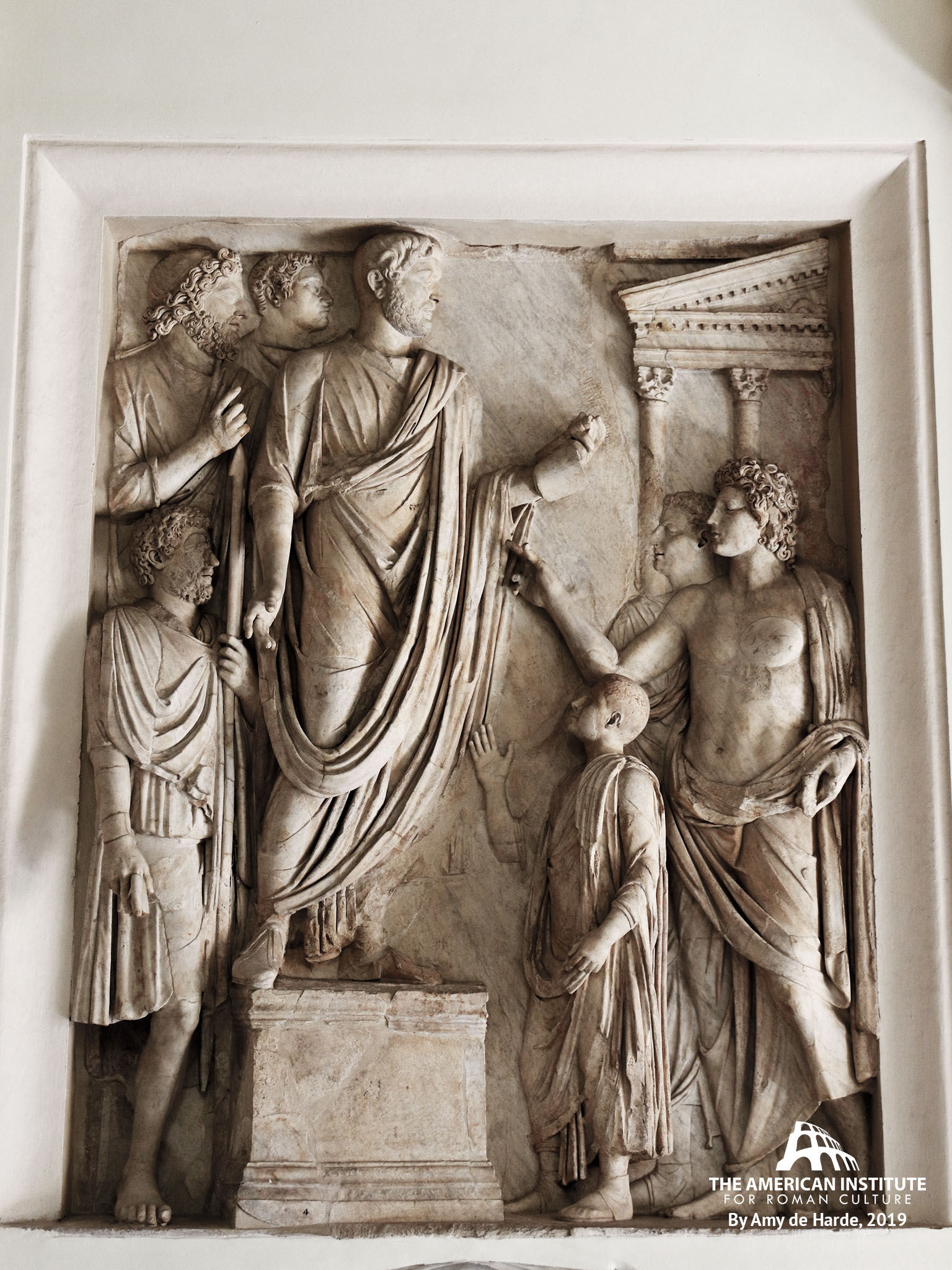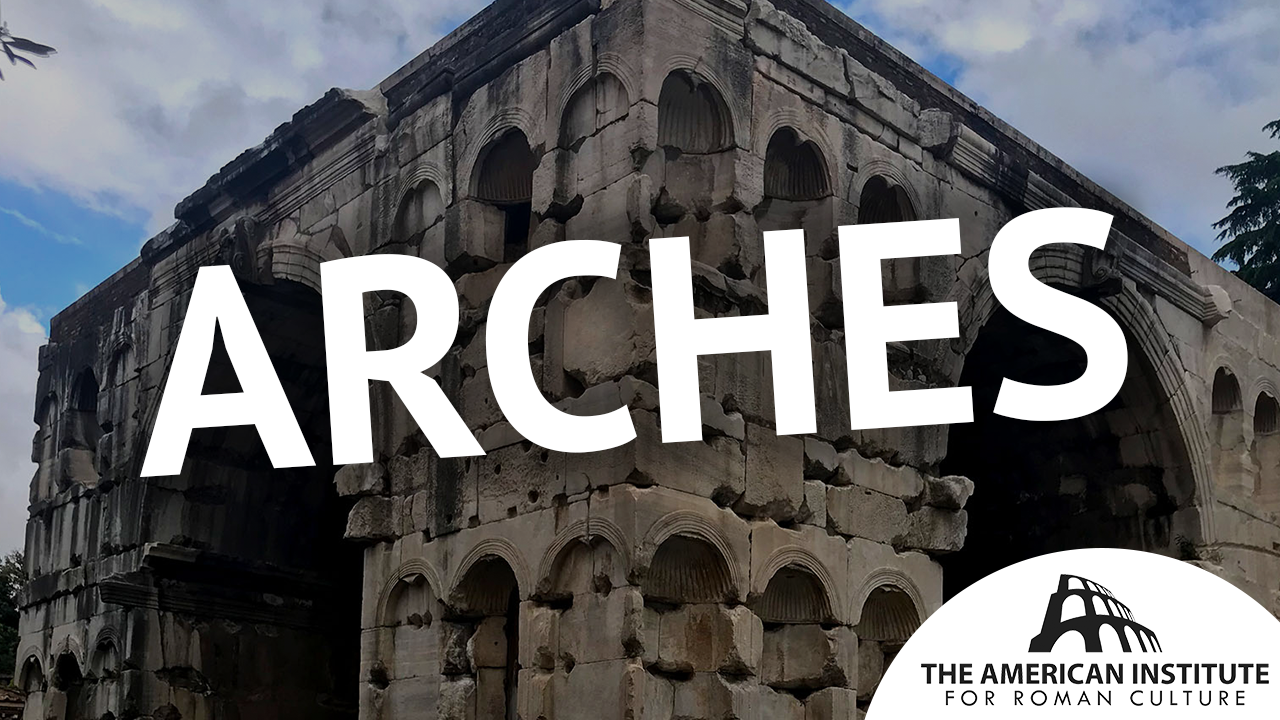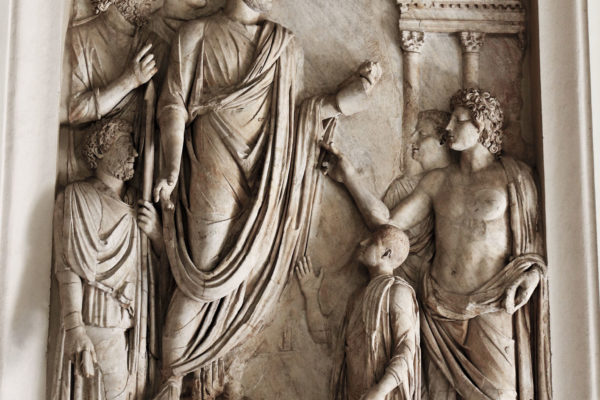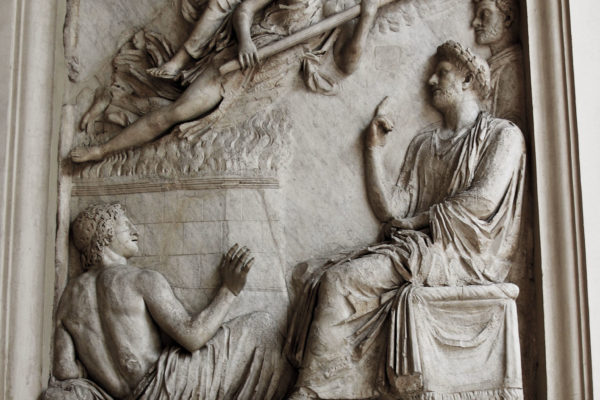Start with our video overview:
The Arch of Portugal, also referred to as the Arch of Hadrian, was a prominent arch located in Rome. Positioned on the ancient Via Lata, now known as the Via del Corso, it stood near the junction with the Via della Vite. Its name, Arch of Portugal, was derived from its proximity to the Palazzo Peretti-Fiano, the residence of the Portuguese ambassador Jorge da Costa from 1488 to 1508. Contemporary studies now attribute the arch to the late antiquity period, potentially built during the reign of Emperor Aurelian (270-275 CE). The arch is believed to have served as an impressive entrance to Aurelian’s Temple of the Sun.
The arch featured reliefs from the time of Emperor Hadrian, approximately 140 years before Aurelian’s reign. These reliefs were likely repurposed as spolia to adorn the monument constructed under Aurelian, following the tradition of reusing earlier reliefs from Trajan’s time when embellishing the Arch of Constantine. Among the surviving reliefs, one depicts Emperor Hadrian overseeing the distribution of food relief to Roman children, while another portrays the apotheosis of Vibia Sabina, the deceased wife of the emperor. The third relief, possibly related but discovered separately, showcases the adventures of Hadrian, depicting the emperor being welcomed by personifications representing the goddess Roma, the Roman Senate, and the people of Rome. This third relief was uncovered in the Piazza Sciarra.
Constructed using blocks of travertine, the arch boasted columns with Composite order capitals, blending elements from both the Ionic and Corinthian orders. Originally featuring a single arch, parts of the arch, including the archway and entablature, were removed between 1550 and 1565.
In 1662, Pope Alexander VII ordered the demolition of the Arch of Portugal due to its deteriorating condition and obstruction of traffic flow along the Via del Corso. A plaque commemorating its demolition was placed at the site in 1665. The three Hadrianic reliefs were relocated to the staircase of the Palazzo dei Conservatori, now known as the Capitoline Museums.
The Arch of Portugal, played a significant role in Rome’s architectural landscape. Although specific details regarding its design and construction remain uncertain, the arch was adorned with reliefs from the Hadrianic era and stood as an important monument in the city. Drawings from the 16th and 17th centuries depict a single arch flanked by columns and crowned with a cornice. The architecture suggests a period later than that of Hadrian, potentially dating to the fourth or fifth century. It is speculated that the arch was built using fragments from earlier structures, similar to the approach taken with the arch of Constantine. One side of the arch was demolished in the 12th century, and a fragment of the cornice was relocated to the Church of Santa Maria in Trastevere.
Sources
- Richardson, L. (1992) A New Topographical Dictionary of Ancient Rome.
- Ward-Perkins, John Bryan.(1994) Roman Imperial Architecture. Penguin Books.
- Platner, S. B., & Ashby, T. (1929). Topographical Dictionary of Ancient Rome. Oxford University Press.
- Coarelli, Filippo. (2008) Rome and Environs: An Archaeological Guide. University of California Press.
Explore further:
Arco di Portogallo: an arch over the via Lata close to the Ara Pacis, which is often called Arcus Hadriani, because of two reliefs of the Hadrianic period that adorned it and are now in the Palazzo dei Conservatori (Helbig, Führer3, 897, 900; Strong, Sculpture 236‑8; SScR 213‑215; PBS IV.258‑263; V.180; Cons. Cat. 36, 266). The keystone is also in the same place (ib. 37). This arch was removed in 1662 by Alexander VII in order that the Corso might be widened. It was known earlier as the arcus Octaviani (PBS III.269‑271), but from the sixteenth century it was called Arco di Portogallo because it adjoined the residence of the Portuguese ambassador, the Palazzo Peretti-Fiano. The foundation of one of the piers has been found beneath the present palace, 2.36 metres below the level of the Corso. Extant drawings of this arch, dating from the sixteenth and seventeenth centuries (HJ 466; PBS II.35, and No. 52; LR 507), show a single archway flanked on each side with two columns, and surrounded with a cornice (Ill. 2). The architecture seems to belong to a period later than that of Hadrian, and it is quite possible that the arch itself is of considerably later date — being in fact sometimes assigned definitely to Marcus Aurelius — and that it was decorated with sculpture from earlier monuments, as was the case with the arch of Constantine. Indeed, Hülsen (DAP 2.xi.174) believes it to belong to the fourth or fifth century, and to have been built with fragments of earlier buildings. One of the sides was demolished in the twelfth century, when a fragment of the cornice was removed to S. Maria in Trastevere (HJ 465‑468; BC 1891, 18‑23; 1896, 239‑246; 1915, 333). This is against its having been a ‘mediaeval pasticcio’ (Cons. 36).
This content is brought to you by The American Institute for Roman Culture, a 501(C)3 US Non-Profit Organization.
Please support our mission to aid learning and understanding of ancient Rome through free-to-access content by donating today.
Cite This Page
Cite this page as: Darius Arya, The American Institute for Roman Culture, “Arch of Portugal (Arco di Portogallo)” Ancient Rome Live. Last modified 11/11/2019. https://ancientromelive.org/arch-of-portugal-arco-di-portogallo/
License
Created by The American Institute of Roman Culture, published on 11/11/2019 under the following license: Creative Commons: Attribution-NonCommercial-ShareAlike. This license lets others remix, tweak, and build upon this content non-commercially, as long as they credit the author and license their new creations under the identical terms. Please note that content linked from this page may have different licensing terms.





